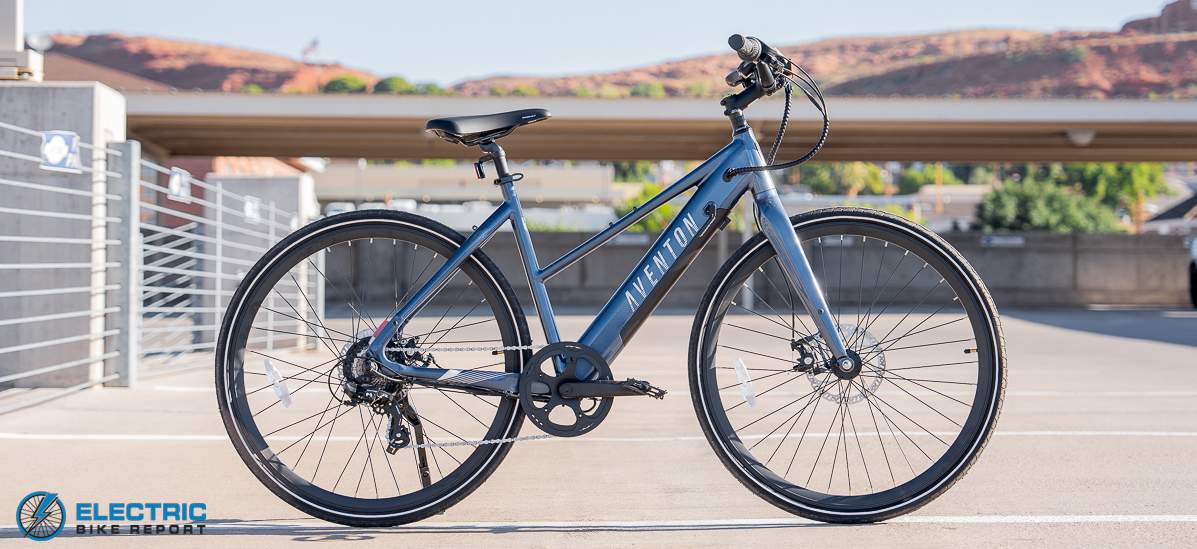The Speed Test tells us the top speed this bike reaches at each pedal assist (PAS) level. The Aventon Soltera.2 Step-through is spec’d with a relatively modest 350W hub motor. In many bikes that might not bode well for acceleration or top speed, but thanks to its low weight—just 46 lbs.—the Aventon Soltera.2 ST makes great use of its hub motor.
The Soltera.2’s 350W motor features a brushless, geared design governed by a torque sensor, rather than the much more common cadence sensor.
In our speed test, we ride the e-bike in question with the motor off and at each of the different PAS levels to see what sorts of speeds a rider can expect, based on their choice. Because conditions like rider weight, surface quality, terrain and wind can all play a part in how an e-bike performs, these results should be considered relative.
In our first test, with the motor off, we say a fairly normal speed of 10.6 mph. This reflects a moderate effort that would allow us to carry on a conversation with another rider. When we set the PAS to Eco mode, the motor kicked in for a 4.3 mph assist, boosting the Soltera.2 ST up to 14.9 mph, which was a great result. Too often, we see e-bikes that don’t offer any appreciable assistance in Eco or PAS 1. Not only was the assistance enough to be noticeable, it was quick enough to satisfy someone looking to balance speed and range.
When kicked up to Tour mode, the Soltera.2 Step-through accelerated an additional 2.2 mph, taking our speed up to 17.1 mph, again, enough to make for a noticeable gain. When we went for Sport mode, the e-bike picked up another 1.5 mph, for a speed of 18.6 mph. This wasn’t as satisfying a jump, but it did make a difference.
The Soltera.2 ST tops out in Turbo mode at precisely 20 mph, a 1.4 mph gain over Sport mode. Considering this is a Class 2 e-bike (20 mph max assist, plus a throttle that tops out at 20 as well), actually hitting 20 mph is pretty terrific.
That the Soltera.2 Step-through was able to achieve 20 mph in Turbo mode is a terrific demonstration that a 350W motor can deliver enough power to be effective, and as we’ve mentioned, that owes in part to this e-bike’s 46-lb. weight.
Another ingredient in this e-bike’s performance are its tires. Where we often see big, fat, knobby tires to give riders a cushy ride, the Aventon Soltera.2 ST is equipped with a nearly slick 38mm-wide (1.5 in.) tire. This tire has a much smaller footprint on the ground, which helps the Soltera.2 Step-through accelerate and reach top speed with relative ease. It’s a bit less comfortable than a bigger tire, but it will pay another dividend that will show up in our range test.
As we mentioned, the Aventon Soltera.2 ST is equipped with a torque sensor. A torque sensor talks to the motor in a manner that is different than a cadence sensor, fundamentally changing how the motor springs into action. With a cadence sensor, the motor waits for a signal that tells it whether the rider has begun pedaling. With most cadence sensors somewhere between half and ¾ of a pedal stroke is required to kick the motor into life, so there’s always a delay, both in turning on and off.
With a torque sensor the sample rate is thousands of times per second rather than large fractions of a turn of the pedals. The difference becomes apparent the moment the rider pushes the first pedal down—the motor responds immediately. Not only that, the motor acts in proportion to the rider’s effort; when the rider pedals harder the controller detects an uptick in torque and it follows suit.
What this means is that the rider has fine control over the e-bike’s speed simply by varying how hard they push the pedals. And our results in our speed test do not reflect that there was room to pedal both harder and softer.
.
.
.
#Aventon #Soltera #StepThrough #Review #Electric #Bike #Report
Source link









